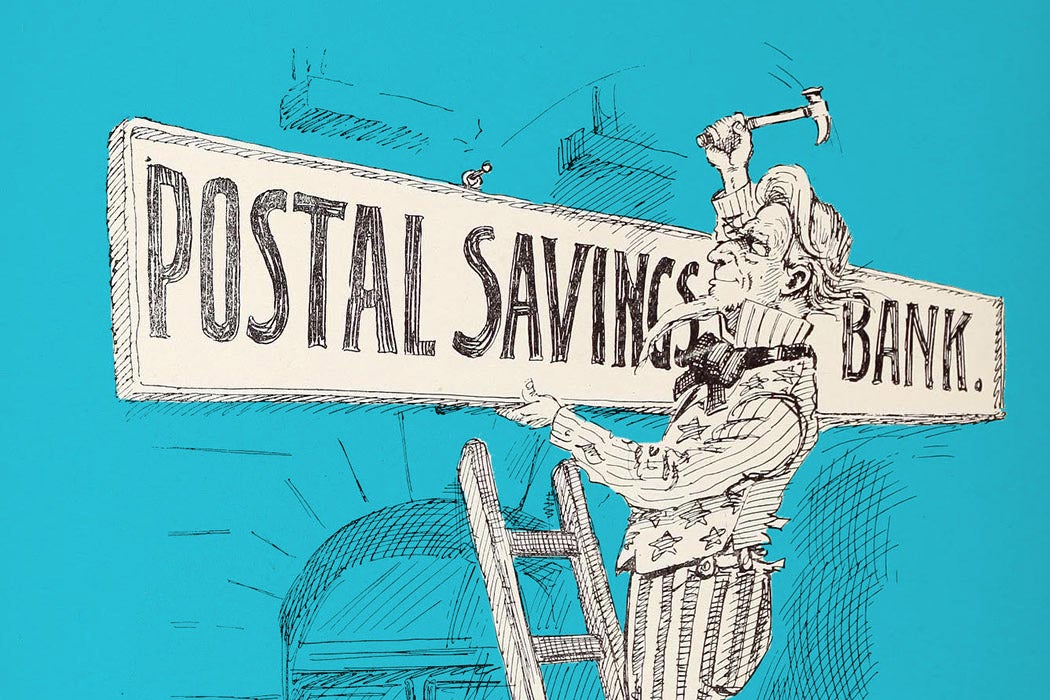Post offices in the United States used to host the Postal Savings System. It was a form of non-profit savings bank and existed from 1911 to 1966. Historian Christopher W. Shaw tracks the “life and death” of this public bank, which gave “a measure of financial security” to small depositors and allowed for a “reimagining of the basic order of the financial system.”
“Millions of Americans deposited their earnings at the local post office,” Shaw writes, noting that
these savers sought the security that the national government’s guarantee of their deposits afforded. Bankers had lobbied hard against the Postal Savings System’s establishment and opposed subsequent efforts that workers and farmers made to expand the institution.
In fact, the “banking fraternity would maintain its enmity toward the government’s savings bank” for its half-century lifespan. Bankers finally killed it off in 1966, ironically aided by the New Deal’s rescue of their for-profit banking systems and the post-WWII “decline in popular political engagement with economic issues.”
The first postal savings system was set up in Great Britain in 1861. As Shaw details, the demand for postal savings in the US came out of the fierce struggle between workers/farmers and bankers in the late nineteenth century. Such entities as the Knights of Labor, American Federation of Labor, the National Grange, and the People’s Party all championed the idea of an alternative to for-profit banking. In the words of the New York State Knights of Labor, the nation needed a Postal Savings Banks to keep people’s monies “safely from the itching palms of the stock-jobbing bank officials.”
Like many of the compromises in the unending battle of the many versus the elite few, the 1910 Postal Savings Bank Act was modest. The system could operate “only in designated post offices, redeposit its funds in existing banks, and pay a noncompetitive 2 percent interest rate,” Shaw writes. There was also a $500 deposit ceiling. And virtually no money was ever spent on publicizing the service.
But, as the Boot and Shoe Workers Union declared, the Act established the principle of postal savings. Supporters hoped there would be opportunities to expand it. Ferocious opposition by bankers, however, prevented such expansion, except for an increase in the deposit ceiling to $2,500 in 1918.
In the 1910s, most postal depositors were in the Northeast and West and were typically new immigrants, not a few of whom had had experience with such systems in Europe. Southern and Midwestern depositors started using the system in greater numbers in the 1920s. Shaw notes that miners in particular favored postal banking. In 1930, the highest per capital deposits in the system were found in Roundup, Montana.
Then came the Great Depression. Between 1930 and 1933, more than 9,000 banks failed across the country, as “falling asset values, loan defaults, heavy withdrawals, illiquidity, and mismanagement” contributed to an unprecedented banking crisis. Bank deposits fell from $59.8 billion to $45.9 billion during this period. At the same time, postal savings deposits “skyrocketed from $164 million to $902 million.” It was a bank-rush in reverse: Americans flocked to the safety of the postal office to open accounts.
Faced with the economic suicide of capitalism, President Roosevelt’s New Deal worked to save private bankers rather than expand the Postal Savings System. Federal deposit insurance (FDIC) also helped shore up disgraced bankers and gave the public more confidence in banks. The affordable credit systems inaugurated by the New Deal, meanwhile, addressed “a central concern of postal savings advocates,” Shaw explains.
Weekly Newsletter
Nevertheless, postal savings persisted. At its peak in 1947, the system had $3.4 billion on deposit. But a rising middle class, boosted into a better post-war life by government action and spending, began to think of postal savings, especially with its low interest rate, as a thing of the past. Writes Shaw, “the increase in Postal Savings System deposits did not revitalized popular political engagement with the institution.”
Bankers’ representatives in Congress finally managed to end postal savings in 1966, when the system was still being used by a million depositors.
Today, banking is an oligopoly “too big to fail” and with outsized influence in politics. For many it’s hard to imagine banking alternatives—yet our history and the continuance of postal savings systems elsewhere in the world point to other ways.
Support JSTOR Daily! Join our membership program on Patreon today.







